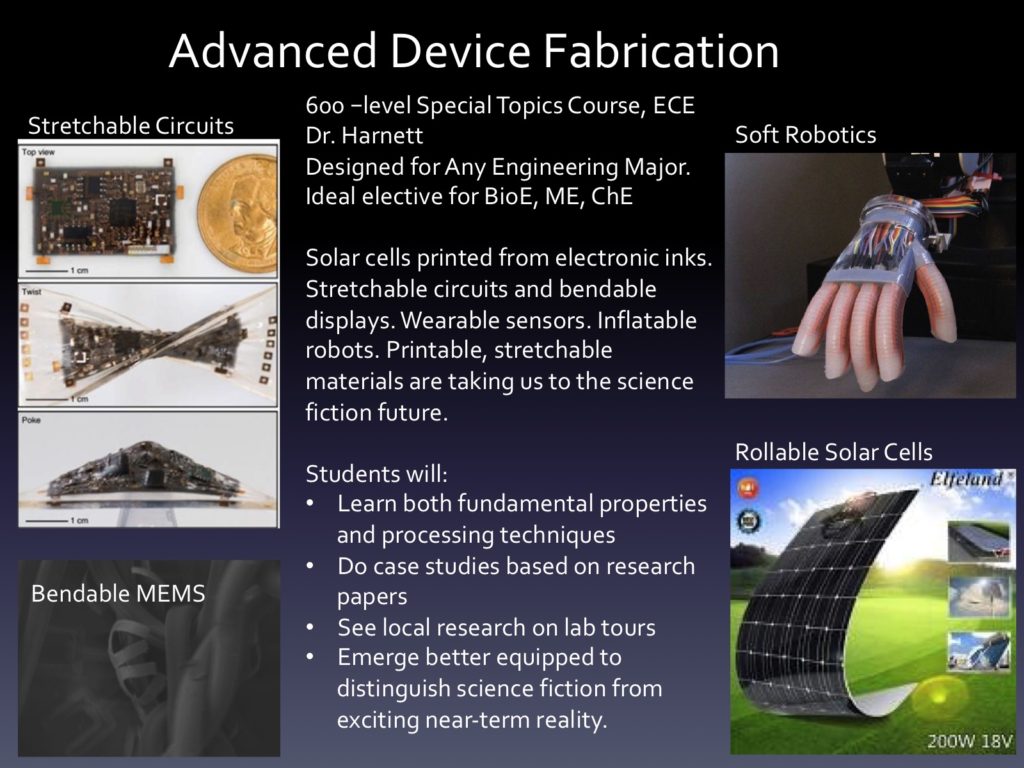
Textbooks: 1. Course notes free from instructor. 2. Plastic Fantastic
I want a reminder near enrollment time/I have a question
Enrollment details:
-No prerequisites for Speed Masters and PhD students
-Undergraduates interested in taking a 600-level course must have permission from their department chair; your academic counselor can help get that request started.
-If outside the ECE dept, please discuss with your academic counselor for assistance enrolling. The instructor is happy for non ECE Masters/PhD students to enroll unless the course interferes with your other degree requirements. Your academic counselor can check it for you.
-Non-ECE students interested in taking the course specifically as an MEng technical elective must have it approved by their department. Again, your academic counselor can get that request started.
Detailed course description and schedule:
Solar cells printed from electronic inks. Stretchable circuits and bendable displays. Wearable sensors. 3D printed biological tissues. Fibers that sense and actuate. Soft inflatable robots. These “extreme machines” show how printable, soft, and stretchable materials are taking us to the science fiction future. How can we make devices with them?
Compared to the 70+ year history of semiconductor electronics, these soft material systems are young. Advances in semiconductors gave us computers. Now, low-cost computers make it possible to 3D print, pattern, and assemble soft materials with new functions. New forms of materials include nanoparticle inks that conduct electricity and emit light. Tissue engineers now use soft 3D printable biocompatible materials to host biological cells and sculpt them into organs. Conventional semiconductors recently joined the soft materials family in ultrathin forms that are flexible and even stretchable.
Students will use course notes to review the fundamental properties of soft materials, and do selected readings to define processing-based limits. Through homework assignments and case studies, the class will determine how to align, combine, and characterize soft materials for specific applications. Students will tour labs in ECE, ChE and BioE, and then do individual reports related to a current or their own possible future research topic.
Not planning on a research path? Leap ahead in your career with next-generation fabrication methods, and emerge better equipped to distinguish science fiction from exciting near-term reality.
Week 1
Soft Materials Families:
Nanoparticle/Fiber/Polymer/Thin films —
Our course modules are organized in the order of this material family tree.
Scaling plots. Fundamentals and homework
Week 2
Nanoparticles:
Fundamentals and homework – Nanoparticle self assembly forces
Nanoparticle behavior in solutions, on surfaces and when drying
Making silver colloid ink
Week 3
Nanoparticle processing:
Solution processing: Inkjetting, spraying. Optomec and Dimatix
Semiconductor nanoparticle ink/Solar cell lab
Week 4
Mechanics:
What does ‘soft’ mean: it stretches or bends a ‘lot’ for a ‘small’ force
Fluid flow (need this later when discussing hydrogel printing)
Capillary forces & other forces in soft materials: fundamentals and homework
Soft to hard interface problem
Week 5
Soft Robotics:
Elastomers, what are they
Sacrificial materials, what and why
Applications and homework
Week 6
Fibers:
Mechanical properties of fibers
Extrusion
Liquid crystal elastomer actuator fibers, coiled polymer actuator fibers
Polymers + Fibers: a composite soft material
Fiber reinforced soft robots: lab visit
Week 7
Optics:
Fiber optics
Optical properties of soft materials
Stretchable optical fibers
Quantum dots revisited (because of their optical properties)
Week 8
Gels:
Hydrogels, micelles
3D printing micro and macro objects from gels–Resolution limits homework
Biological applications overview. Tissue printing requirements for biocompatibility.
Gel printing tour (lab hydrogel printer & enzymes)
Week 9
Electronics:
Review concepts: conductivity, LEDs, transistors
Review what is already happening: Flexible circuit industry, anisotropic conductive films are commercial. Some are intrinsically stretchable (zebra connectors) others just bendable. Liquid metals are still cutting-edge.
PEDOT, organic semiconductor inks (and other materials) for flexible displays
Plastic Fantastic: hype vs reality.
Commercial products with organic semiconductors: lightweight, yet giant TVs
Week 10
Thin Films:
Conventional semiconductors as flexible materials: stretchable electronics from thin films
What are thin films? What about graphene?
What makes a thin film “stretchable?” Fundamentals and homework
Week 11
Case Studies:
Students present case studies from assigned journal papers. Students can develop final presentations on this, or a different topic.
Week 12
Compliant microlectromechanical systems (MEMS):
MEMS as soft materials: Compliant MEMS membranes and structures
MEMS crash course, fundamentals and homework
MEMS lab tour: Compliant MEMS fabric grippers
Week 13
Advanced topics: soft flexible electrode arrays for brain/nerve/skin interaction
Advanced topics: soft paper and thread-based chemical sensors
Advanced topics: soft robotic skins
Week 14
Advanced topics: integrating soft materials into wearable systems
Advanced topics: wearability/washability/user acceptance
Advanced topics: soft materials for energy harvesting
Week 15
Individual presentations.